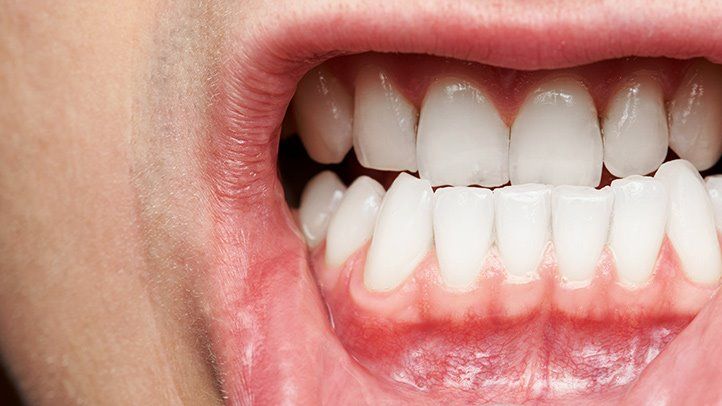White Gums: Causes & Treatments

White gums refer to the abnormal whitening of the gum tissue in the mouth. This discoloration can manifest as patches, spots, or an overall pale appearance of the gums.
White gums can be a symptom of various underlying health issues, so you should see your dentist as soon as you notice this weird phenomenon.
Key Takeaways
- White gums require attention: While sometimes temporary, white gums should not be ignored. They may signal underlying health issues.
- See a dentist: A dentist or healthcare provider can determine the cause of white gums and provide the appropriate treatment.
- Causes vary greatly: White gums can stem from causes ranging from mild (gingivitis, post-tooth extraction healing) to potentially serious (oral cancer, lichen planus, fungal infection).
- Treatment depends on the cause: Treatments range from improved brushing to medications to surgical interventions.
- Oral health is crucial: Good oral hygiene (regular brushing, flossing) helps prevent oral thrush, gingivitis, and other causes of white gums.
- Temporary side effects are possible: Teeth whitening or tooth extraction can sometimes cause temporary white gums which usually resolve on their own.
Table of Contents
Is white gums serious?
While not all cases of white gums are immediately serious, it’s essential to pay attention to changes in the color or appearance of your gums and seek prompt medical attention if you notice any abnormalities.
Some potential causes of white gums, such as oral thrush or oral lichen planus, may require medical treatment to prevent complications and alleviate symptoms.
On the other hand, white gums caused by poor oral hygiene or gingivitis can progress to more severe gum disease if not addressed.
In some cases, white gums may be a sign of oral cancer, particularly if they are accompanied by other symptoms such as persistent sores, swelling, or difficulty swallowing. Oral cancer can be serious and potentially life-threatening if not detected and treated early.
Overall, while white gums may not always indicate a serious health issue, it’s essential to have them evaluated by a dentist or healthcare professional to determine the underlying cause and appropriate treatment.
What are the main causes of white gums?
Oral Thrush
Oral thrush, also known as oral candidiasis, is a fungal infection caused by Candida yeast. It can occur when the balance of microorganisms in the mouth is disrupted, allowing Candida to overgrow.
White patches resembling cottage cheese may develop on the gums, tongue, or inner cheeks.
Factors such as a weakened immune system, antibiotic use, or underlying medical conditions like diabetes can increase the risk of oral thrush.
Leukoplakia
Leukoplakia refers to thickened, white patches that develop on the gums, tongue, or inside of the cheeks. These patches can result from chronic irritation, such as smoking, tobacco use, or rough surfaces in the mouth.
While leukoplakia is usually benign, it can sometimes indicate a precancerous condition, particularly if the patches don’t disappear after the irritant is removed.
Gingivitis
Gingivitis is the early stage of gum disease, characterized by inflammation of the gums. Plaque, a sticky film containing bacteria, can accumulate along the gumline and cause irritation, leading to redness, swelling, and bleeding. In some cases, the gums may appear white due to the inflammation and buildup of plaque and tartar.
Oral Lichen Planus
Oral lichen planus is an autoimmune disorder that can affect the mucous membranes inside the mouth, including the gums. It may present as white, lacy patches or lesions on the gums and other oral tissues.
While the exact cause of oral lichen planus is unknown, it’s believed to involve an abnormal immune response. Treatment focuses on managing symptoms and may include corticosteroid medications.
Poor Oral Hygiene
Inadequate brushing and flossing can lead to the accumulation of plaque and tartar on the teeth and gums. This can cause inflammation of the gums known as gingivitis, which may result in redness, swelling, and in some cases, the gums may appear white due to the presence of plaque and inflammation.
Oral Cancer
In rare cases, white patches on the gums could be a sign of oral cancer. Oral cancer can develop on the gums, tongue, lips, or other oral tissues and may present as white or red patches, ulcers, or lumps. Other symptoms may include difficulty swallowing, persistent sore throat, or a change in voice. Risk factors for oral cancer include tobacco use, excessive alcohol consumption, and HPV infection.
Treatment for White Gums
The treatment for white gums depends on the underlying cause. Here are some potential treatments for various conditions that can cause white gums:
Oral Thrush
Antifungal Medications: Your dentist or doctor may prescribe antifungal medications, such as clotrimazole lozenges or nystatin mouthwash, to treat oral thrush. These medications help eliminate the Candida yeast responsible for the infection.
Leukoplakia
Tobacco Cessation: If leukoplakia is caused by chronic irritation from smoking or chewing tobacco, quitting these habits is crucial to prevent further irritation and potential progression to oral cancer.
Removal of Lesions: In some cases, your dentist may recommend removing leukoplakic lesions through surgical procedures, such as scalpel excision or laser surgery.
Gingivitis
Improved Oral Hygiene: Practicing good oral hygiene habits, including brushing your teeth twice a day, flossing daily, and using an antimicrobial mouthwash, can help reduce plaque buildup and inflammation.
Professional Dental Cleaning: Your dentist may perform a professional dental cleaning to remove plaque and tartar from the gumline and teeth, promoting gum health.
Oral Lichen Planus
Corticosteroids: Topical or systemic corticosteroid medications may be prescribed to reduce inflammation and alleviate symptoms associated with oral lichen planus.
Immunosuppressants: In some cases, medications that suppress the immune system’s response may be prescribed to manage symptoms of oral lichen planus.
Poor Oral Hygiene
Improved Oral Hygiene Practices: Enhancing your oral hygiene routine by brushing and flossing regularly and using an antimicrobial mouthwash can help remove plaque and prevent gum inflammation.
Oral Cancer
Surgical Removal: Treatment for oral cancer often involves surgical removal of cancerous lesions, followed by reconstructive surgery if necessary.
Chemotherapy and Radiation Therapy: In advanced cases of oral cancer, chemotherapy and radiation therapy may be recommended to kill cancer cells and prevent further spread of the disease.
Targeted Therapy: Some cases of oral cancer may be treated with targeted therapy medications that specifically target cancer cells while minimizing damage to healthy tissues.
White Gums After Tooth Extraction
After a tooth extraction, it’s fairly common to see white gums around the socket. Here’s the breakdown:
Possible Causes
There are two main reasons for white gums after extraction:
- Granulation Tissue: This is the most likely scenario. Granulation tissue is a collection of white blood cells, collagen, and blood vessels that form naturally to fill the socket and kickstart healing. It’s a good sign!
- Plaque Buildup: Brushing and flossing might be difficult near the extraction site, allowing plaque, a sticky film of bacteria, to accumulate. This appears white and should be gently removed once you can resume normal brushing.
When to Worry
While white granulation tissue is normal, some situations might require a dentist’s attention:
- Severe Pain: If the white tissue is accompanied by throbbing pain, it could indicate an infection or “dry socket,” a condition where the blood clot protecting the bone gets dislodged.
- Prolonged Presence: Granulation tissue usually appears a few days after extraction and lasts for a week or two. If the white persists much longer, consult your dentist.
Here’s how to manage white gums after extraction:
- Maintain Gentle Oral Hygiene: Brush carefully around the extraction site as instructed by your dentist. Use a soft-bristled brush and avoid harsh rinsing.
- Follow Post-operative Instructions: Your dentist will provide specific instructions on care, including medication and dietary restrictions.
- Schedule Follow-up Appointments: Attend all scheduled checkups so your dentist can monitor healing.
If you have any concerns about the white gums or experience unusual pain, don’t hesitate to contact your dentist for further evaluation and guidance.
White Gums After Teeth Whitening
White gums after teeth whitening can be a concern, but it’s usually a temporary side effect. Here’s a deeper dive into what’s happening and how to manage it:
The most likely culprit is irritation from the whitening product’s bleaching agents, typically hydrogen peroxide or carbamide peroxide.
These agents effectively whiten teeth, but if they come in contact with your gums for extended periods, they can cause temporary inflammation and blanching (whitening) of the gum tissue.
In most cases, the white gums are a sign of mild irritation and shouldn’t be a major cause for alarm. This typically resolves on its own within 24-72 hours, though it can sometimes linger for a few days. You might also experience some discomfort or a burning sensation in the affected areas.
Here are some steps to help your gums recover:
- Cool Saltwater Rinse: Make a warm saltwater solution (a teaspoon of salt in warm water) and gently swish several times a day. This reduces inflammation and promotes healing of the irritated gum tissue.
- Gentle Brushing: Brush carefully around the whitened teeth and gums, using a soft-bristled brush and avoiding harsh scrubbing. This removes any lingering irritants and maintains good oral hygiene, which is crucial for healing.
- Over-the-counter Pain Relief: If you experience discomfort, consider taking an over-the-counter pain reliever like ibuprofen or acetaminophen for temporary relief.
Seek medical help if the white gums persist for more than a few days, become more severe, or are accompanied by additional symptoms like:
- Bleeding gums
- Severe pain or swelling
- Signs of infection (fever, bad taste in your mouth)
Prevention Tips
To minimize the risk of white gums during whitening, here are some proactive measures:
- Follow Instructions Carefully: This seems simple, but it’s crucial. Pay close attention to the directions on your whitening product, particularly regarding application time and avoiding contact with your gums. Most products will recommend applying a barrier (like petroleum jelly) around the gum line to minimize contact.
- Properly Fitted Mouth Guard: If you’re using a whitening tray, ensure it fits snugly and comfortably. A loose or ill-fitting tray can allow excessive contact with the gums, increasing the likelihood of irritation. Consider consulting your dentist for a custom-made tray for the best fit and whitening results.
- Sensitivity Relief Products: Some whitening products are formulated specifically for people with sensitive teeth and gums. These products often contain lower concentrations of bleaching agents or incorporate ingredients to soothe potential irritation. Discuss your options with your dentist to find a product that effectively whitens your teeth while minimizing the risk of gum discomfort.
Remember, open communication with your dentist is key throughout the teeth whitening process. If you experience any unusual symptoms or have concerns during or after whitening, don’t hesitate to consult your dentist for personalized advice.
FAQ on White Gums
What are the potential causes of white gums?
Clinicians frequently encounter patients with pale or white gum tissues. Several conditions can manifest this way, including lichen planus, aphthous ulcers (canker sores), nutritional deficiencies (particularly anemia), and leukoplakia. Fungal infections, such as oral thrush, can also cause white patches on the gums.
Is it indicative of a serious condition?
The severity of white gums depends on the underlying cause. Gingivitis, the early stage of gum disease, can present with mild paleness or redness. However, persistent white patches or lesions warrant further investigation to rule out more concerning conditions like oral lichen planus or leukoplakia.
Should I seek professional evaluation?
We strongly recommend scheduling a dental appointment if you notice any changes in your gum color or texture. Early diagnosis of gum disease or other conditions is crucial for successful treatment and maintaining optimal oral health.
How can I prevent white gums?
The best way to prevent gum problems, including those that manifest with white gums, is meticulous oral hygiene. Brushing twice a day with fluoride toothpaste, flossing daily, and attending regular dental checkups (including cleanings) significantly reduce the risk of gum disease and other potential causes of white gums.
Fact Checked
Our dedicated team rigorously evaluates every article and guide to ensure the information is factual, up-to-date, and free of bias.
Updated Regularly
We update our articles and reviews regularly to ensure you have access to the latest data in the dental industry.
The content on Dental3DU’s blog is intended for educational purposes only. This information should not be relied upon as professional medical counsel. Be sure to always consult with your dentist about the dangers and benefits of any medication, treatment or procedure.







